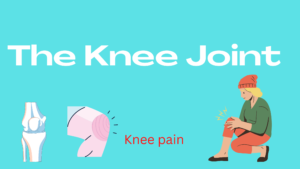
The knee joint is a hinge type synovial joint, which means it is a freely moving joint with a lubricating sac surrounding it. The knee joint is formed by the lower end of the femur (thighbone) and the upper end of the tibia (shinbone). These bones are connected by ligaments, which help to hold the knee in place and provide stability. The knee joint also contains two small bones, called the patella (kneecap), which sits in front of the knee and helps to protect it. The knee joint allows for a wide range of motion, including flexion (bending), extension (straightening), and rotation. The knee joint is one of the largest and most complex joints in the body.
Knee Pain Articulating Surfaces
There are three articulating surfaces in the knee joint. The medial and lateral condyles of the femur articulate with the tibia, and the patella articulates with the femur. These articulating surfaces are covered with articular cartilage, which allows for smooth movement of the joint.
The medial and lateral condyles of the femur are slightly concave, while the tibia is slightly convex. This helps to distribute weight evenly across the joint and prevents dislocation. The patella is a flat bone that sits in front of the knee joint and protects it from impact.
The knee joint is held together by ligaments, tendons, and muscles. The ligaments connect the bones and provide stability to the joint. The tendons attach muscles to bones and help move the joints.
Tibiofemoral
The knee joint is the largest and most complex joint in the human body. It is a weight-bearing joint that allows us to walk, run, and jump. The knee joint is made up of the bones of the thigh (femur) and lower leg (tibia), as well as the patella (kneecap). The ends of these bones are covered with a smooth layer of cartilage, which allows for smooth movement at the joint.
The knee joint is held together by a network of ligaments and tendons. The quadriceps tendon attaches the quadriceps muscle (thigh muscle) to the patella. This muscle group helps to straighten the leg at the knee. The patellar tendon attaches the patella to the tibia.
Patellofemoral
The patellofemoral joint is the joint between the patella (kneecap) and the femur (thigh bone). It is a modified hinge joint, with a small amount of gliding motion. The main function of the patellofemoral joint is to allow the leg to extend (straighten), as when walking or climbing stairs.
The patellofemoral joint has two main bony landmarks: the patella and the femoral groove. The patella is a small, triangular bone that sits in front of the knee. The femoral groove is a shallow depression on the anterior (front) aspect of the distal femur. The patella rests in the femoral groove and is held in place by ligaments.
Neurovascular Supply In Knee Joint
The knee joint is a weight-bearing synovial joint that is responsible for the flexion and extension of the leg. The neurovascular supply to the knee joint is provided by the femoral nerve, tibial nerve, and sciatic nerve. The femoral nerve provides innervation to the quadriceps muscles, which are responsible for extending the leg. The tibial nerve provides innervation to the hamstring muscles, which are responsible for flexing the leg. The sciatic nerve provides innervation to the calf muscles, which are responsible for plantarflexing the foot.
The knee joint is supplied by three arteries: the medial collateral artery, lateral collateral artery, and anterior cruciate artery. The medial collateral artery supplies blood to the medial aspect of the knee joint. The lateral collateral artery supplies blood to the lateral aspect of the knee joint.
Bursae
The knee joint is the largest and most complex joint in the body. It is made up of three bones: the femur (thighbone), tibia (shinbone), and patella (kneecap). The knee joint allows for a wide range of motion, including bending, straightening, and rotating. The knee joint is held together by ligaments, which are strong bands of tissue that connect bone to bone. The knee also has a number of bursae, which are small sacs filled with fluid that cushion and lubricate the joint.
Bursae are small sacs filled with synovial fluid that act as cushions between bones, tendons, and muscles. There are more than 150 bursae in the human body, each one serving a different purpose.
Ligaments
There are four main ligaments in the knee joint: the medial collateral ligament (MCL), the lateral collateral ligament (LCL), the anterior cruciate ligament (ACL), and the posterior cruciate ligament (PCL).
The MCL is located on the inner side of the knee joint and helps to stabilize the knee. The LCL is located on the outer side of the knee joint and also helps to stabilize the knee. The ACL is located in the middle of the knee joint and prevents the femur from sliding backwards on the tibia. The PCL is located in the middle of the knee joint and prevents the tibia from sliding forwards on the femur.
All of these ligaments are important for stabilizing the knee joint and preventing injuries.